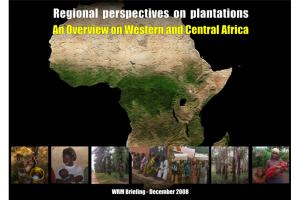The Batwa (often described as “pygmies”) are widely regarded as the original forest-dwelling inhabitants of the Equatorial forest in the Great Lakes Region comprising Uganda, Burundi, Rwanda and the Democratic Republic of Congo. In Uganda, they lived in the forest of the Mufumbira Mountains in the South West. They were hunter-gatherers that relied on the forests for their livelihood and found in the forests the sustenance for their spiritual and social life.
Congo DR
Bulletin articles
29 April 2009
Bulletin articles
30 January 2009
The Inga hydroelectric scheme (Inga 1, Inga 2, Inga 3 and Grand Inga) is located 140 miles southwest of capital city Kinshasa. It lies on the largest waterfall by volume in the world, the Inga falls, where the Congo River drops 96 m (315 ft) over the course of nine miles with an average flow of 42,476 m³/s.
The project started in 1920 during Belgian colonial rule. Colonial authorities forced the site’s first inhabitants to leave without any compensation. Inga’s displaced communities haven’t received any compensation till today.
Publications
15 December 2008
Oil palm and rubber plantations occupy extensive areas in many countries in tropical Africa. In spite of their social and environmental impacts, until now they have received scant attention both at the national and international level.
Bulletin articles
25 November 2008
DRC’s rainforest --the world’s second largest-- is disappearing through logging. According to a report from The Guardian (1), “today a dozen large, mostly European, companies dominate the industry and have vast concessions: Trans-M has Lebanese owners; another group, which controls around 15m acres, is owned by the Portuguese Trinidade brothers; the American Blattner family has more than 2m acres; the German Danzer Group has 5m.
Other information
28 August 2008
The Itombwe Massif lies northwest of Lake Tanganyika (28º02′ - 29º04′ E, 2º41’ - 3º52′ S), stretching over a vast area of 1,600 km2 that encompasses the territories of Mwenga, Fizi and Uvira. It forms part of the Mitumba mountain range, with altitudes ranging from 60 metres above sea level in the western portion to 3,475 metres (Mount Mohi) in the north, with numerous peaks of 2,000 metres or higher, then abruptly dropping to 770 metres in the east, where it borders on Lake Tanganyika.
Other information
28 August 2008
The Democratic Republic of the Congo (DRC) has the second largest tropical rainforest in the world, second only to the Amazon rainforest in Brazil. The country’s forests have recently drawn international attention, not only due to the challenges posed by climate change, but also because of the struggle being waged by Congolese civil society in general, and the environmental movement in particular, to stop the government from lifting its current moratorium on new logging concessions.
Bulletin articles
2 February 2008
Born to independence in 1960, the Democratic Republic of Congo has lived since then amid fighting. Its former colonial ruler Belgium, as well as the US, the EU and international financial institutions such as the World Bank have been key hidden actors and interested parties in a scenario where ethnic rivalry has caught the world attention, while hiding economic struggles over the riches of a country which was the world’s largest cobalt exporter, the fourth biggest diamond exporter and ranked among the top ten world producers of uranium, copper, manganese and tin.
Bulletin articles
3 January 2008
Front-page articles in mainstream newspapers and magazines have pictured Congo’s crisis along the “preconceived notion of the ‘savage,’ ‘depraved’ African”, said Maurice Carney and Carrie Crawford, from Friends of the Congo (FOTC), in their article “Casualties in the Scramble for Congo’s Resources” (at http://friendsofthecongo.org/commentaries/congo_casualties.php).
Other information
18 August 2007
In April 2003, in WRM Bulletin Nº 69, we wrote an article on the Democratic Republic of Congo focused on the exploitation of columbium-tantalite (coltan, for short), widely used in cellular phones, laptop computers and video games, and how the mining of this ore has devastated forests like the Ituri forest, changing forever sites which used to sustain the Mbuti livelihoods and were the habitat of several animals like gorillas, okapis --a relative of the giraffe--, elephants and monkeys. It was a sad picture that coltan left in the forests of DRC, a scenario for war and depredation.
Other information
18 July 2007
Between 1991 and 2001, Shell Renewables -a division of Shell Oil International- implemented a forestry operation based on the planting and harvesting of fast-growing cloned eucalyptus trees (see WRM Bulletin 46), with the aim of establishing a high-yield source of biomass for future energy generation.
Bulletin articles
18 July 2007
Indigenous peoples living in the tropical rainforests of Central Africa are widely dispersed and identify their groups by a variety of names. Numbering a total of 300,000 to 500,000 people, those members of communities from several ethnic groups characterized by their small stature are identified under the generic name of “pygmies” (see WRM Bulletin Nº 119).
Bulletin articles
19 June 2007
More and more the rush to use biomass as an alternative source of energy allegedly to reduce CO2 emissions is concealing the unsustainable consumption pattern that underlies global warming and climate change.
Reduccionist approaches focus on solutions which create even greater harm. That is the case of a major European project which has enthusiastically identified industrial-scale eucalyptus plantations as an answer for so said less polluting steel manufacturing processes.

